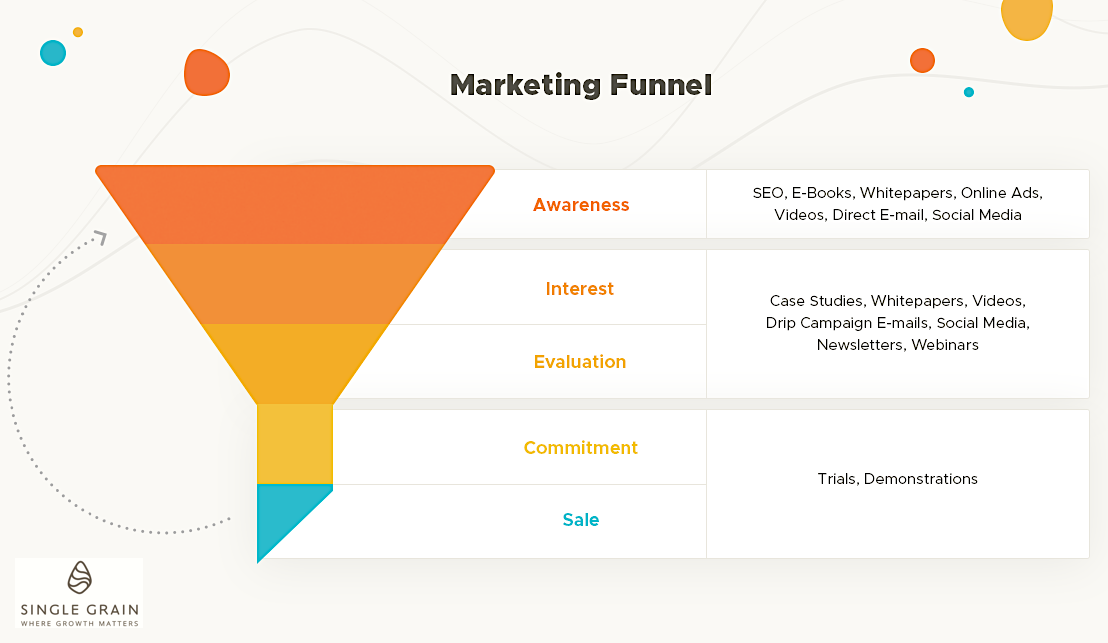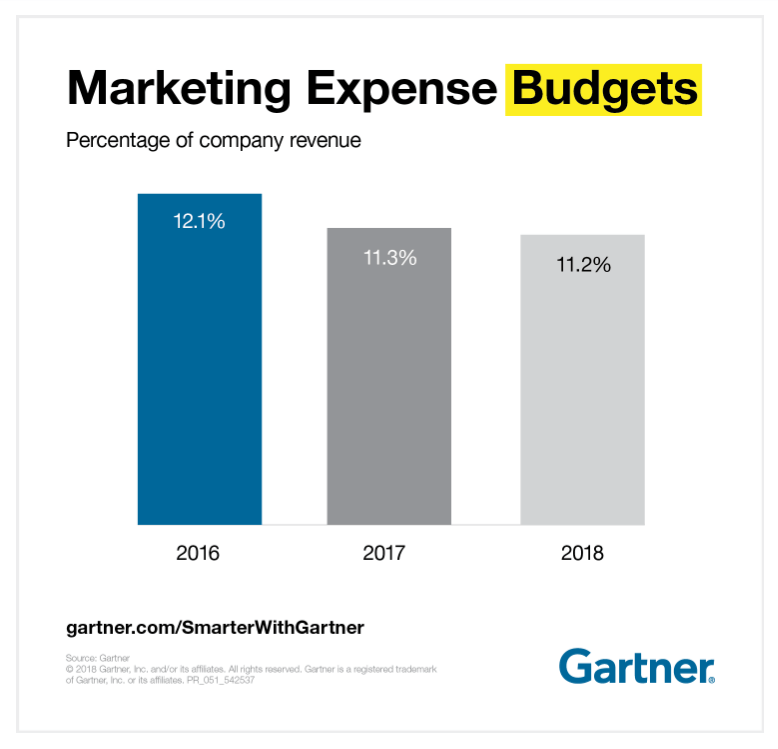Marketing budgets vary widely by industry, company size and business goals. Trying to figure out exactly how much you should be spending can be tricky – and if you ask 10 people what they think, you’re going to get 10 different answers.
For example, the U.S. Small Business Administration recommends spending 7-8% of your company’s revenue on marketing, but in reality, businesses typically spend more than that. Gartner’s 2018 CMO Survey found that marketing budgets actually averaged about 11% of their revenue:

A Radical Way of Looking at Marketing Budgets
You may not like what I’m about to say, and your CFO definitely won’t like it, but it needs to be said. Marketing budgets are useless. That’s my opinion, of course, but it’s an opinion based on experience.
It’s not just me who feels that way – it’s also the big Fortune 1000 companies. I was meeting with a team at a Fortune 1000 company the other day and discussing budgets, and you know what they told me? They said, “Well, here’s our budget, but as long as you can stick within this profit margin or this ratio, we’ll spend as much as we can.”
That’s how businesses that really understand marketing look at it, and that’s the way it should be. If you can spend the money and it’s profitable, why wouldn’t you keep scaling up?
If you can spend one dollar and make three, why wouldn’t you spend $100,000 to make $300,000? And if that works, why wouldn’t you want to scale up to a million or $2 million or $5 million a month? You’d want to spend as much as you could, as long as it kept bringing in more revenue than what you are spending.
Budgets should be based on the profitability of marketing channels, not an arbitrary number set by the finance department. But if your company is more focused on the budget than the ROI, then I’d say to earmark 10-20% of revenue for marketing. Or just tell your CFO that Eric Siu thinks budgets are useless.
Dive Deeper: How to Create a Marketing Budget From Scratch
The Most Important Budget Factor: Resources
Before you set a marketing budget, it’s important to talk to your team about resources. If you don’t have the staff to execute on your marketing strategy, you have a few options:
- Hire internal help: This could be one or more full-time employees, interns or contractors. It all depends on the expertise of your existing staff and where you need to supplement.
- Hire external help: If you can’t execute on your marketing plans internally, then it might be worth hiring a digital marketing agency for some or all of your marketing priorities.
- Hire both: You might need both internal and external help to have adequate resources on-hand for managing your marketing.
I’ve seen a lot of companies fail at maximizing their marketing budget because they didn’t have enough resources to manage it effectively. Whichever way you go, you’ll have to factor the costs of additional help – whether on staff or at an agency – into your budget.
Dive Deeper:
Marketing Budgets for New vs. Established Businesses
You might think that a brand new company should spend less on marketing than an established, profitable one. New companies aren’t making any money yet, right? So how can they set aside a percentage of revenue for marketing? Meanwhile, the big guys have tons of money, so why not spend it?
The problem with being a startup is that you can’t make any money until people know who you are, and you can’t introduce yourself to people at scale without spending. That’s why, in that situation, you should actually be spending more than a Fortune 1000 company. Base your budget on your projected revenue, and try to be on the higher end of the 10-20% figure if you can.
Companies that are already successful, on the other hand, don’t need to market as much. They already have customers, so their marketing isn’t about brand awareness. It’s more about new product launches and special events. As a result, large, profitable companies can get by with a spend that’s closer to 10%.
Spend Your Budget Wisely
When it comes down to spending your money, that’s when I think budgets are actually important. You want to be smart about how you spend your available resources so that you’ll lose as little money as possible.
The first phase of any marketing campaign is experimentation. You want to find out what works before you start pouring money into it. So maybe you want to set aside 10% of your marketing budget for experimentation:

Spend that money to run tests, but when you find out what works, go all-in until it plateaus. Then find something else that works. Focus on just two or three channels to start, and then scale up as you can afford to.
Marketing should be a cash-positive endeavor. The more you test, optimize and reallocate, the more likely it is that you’ll bring in more than you’re spending.
Consider the Lifetime Value of Your Customers
ROI isn’t just about revenue, though. It’s important to also consider the value you’ll gain from your customers.
For example, let’s say you have a SaaS business that costs $100/month. You know that customers tend to stick around for a year or more. If you have to spend $100 for a customer, you’re technically breaking even for that month. However, if your customer remains with you for a year, they are worth $1,200. That $100 was actually a bargain.
To calculate the lifetime value of a customer, use this simple formula:
Annual profits per customer X number of years they remain a customer – acquisition cost
There’s nothing wrong with losing money on the front end if you know you’ll see returns later on. That’s how big companies end up generating hundreds of millions, if not billions of dollars – they’re willing to take a loss upfront because they know the lifetime value of their customers.
Related Content:
Marketing Budgets for Service or Product Businesses
If you have a service-based business, on the other hand, your marketing budget is going to look a lot different than it would if you sold products. There are only so many people you can service at one time, right?
In these cases, you’ll probably want your marketing to look more like a slow trickle that’ll bring in a steady stream of clients rather than a blitz that’ll bring in more leads than you can handle. If you do the latter, you’re just wasting money on marketing. During slower times, you’ll also need the flexibility to increase that budget.
When you have a product-based business, on the other hand, you want to sell as much product as you can as quickly as you can. As soon as you’ve figured out which channels have the best ROI for your brand, any money you spend is going to make you money in return.
Dive Deeper: How to Turn a Minimum Viable Product into a Booming Business
In Marketing, Patience Is a Virtue
A huge mistake I see marketers make is giving up on a channel too soon. Some things – like SEO and content marketing, for example – take months for you to see any kind of results (let alone be able to calculate something like ROI). A Facebook ad campaign, on the other hand, can be measured in real-time. You’ll know within a few days if it’s working.
As you’re spending your marketing budget, make sure to give your channels adequate time to achieve growth. Otherwise, you’re just wasting your budget. You can start small, of course, but do enough to ensure that you’ll have measurable results.
For example, let’s say you want to focus on SEO. You already have a ton of content, much of it evergreen and some of it pretty popular. Maybe, in this case, you don’t invest in creating lots of new content right out of the gate. Instead, you update your most popular content pieces to make them more SEO-friendly, and then promote them like crazy. Then you watch how they perform over the next couple of months and decide how to move forward, based on the data you’re seeing.
Dive Deeper: SEO: How to Help Your Client Understand that Ranking Takes Time
Use Data to Inform Your Marketing Spend
Whenever you’re in the testing phase of marketing (technically, if you’re marketing, you’re always in the testing phase, but just go with it), you need to be keeping a close eye on the analytics. Watching the numbers is the only way to figure out what’s really working.
One problem I see a lot of marketers run into is having more data than they know what to do with. If you’re running a website, email campaigns, social media campaigns and Google Ads, you’re going to have data in a lot of different places – and it’s all going to be measured differently.
My advice? Determine ahead of time which metrics are most important to you, and work backwards from there.

For example, if you have a high-converting landing page that you’re using to funnel customers into purchasing, then your goal is to get people to that page, and you’ll want to know which channel got them there. Then, analyze the click-through rate on each of those channels to determine which one brought the most traffic in.
If you have a clear idea of how your marketing funnel should work, then you can establish benchmarks for every stage of the funnel and analyze the metrics to see which channels work best for each stage of the funnel:

Then you can reallocate your budget to those channels and target the right people based on where they are in the buying process.
But you can’t do any of that if you don’t a) know your target metrics or b) know how to measure them. Invest in your data set-up as early as possible so that you have real performance numbers to work with, rather than educated guesses.
Dive Deeper:
Marketing Spend Is All About the Ratio
In the end, marketing budgets shouldn’t be about setting aside a certain amount of money for marketing. They should be about ratios. Figure out what ratio you need to pay your bills and still be profitable. When you hit that ratio with your marketing channels, pour money into them.
In an episode of The Tim Ferriss Show from earlier this year, Tim interviewed Tobi Lütke, CEO of Shopify. Tobi told a story about how he waited until he had $5,000 a month in additional recurring revenue to start spending on marketing (I wouldn’t recommend that approach, for reasons stated above). He spent $25,000 to test five different ideas he had to see what worked so he could go all-in. Today, Shopify is a billion dollar company.
Once you start generating revenue from your marketing efforts, that’s when you should spend more, not less. If something’s working, max it out. That’s how you scale. And then move on to the next marketing channel and do the same thing. Don’t be afraid to lose a little bit of money at the beginning, but once you’ve determined that a channel definitely isn’t working, cut your losses and try a different approach.
If you must have a marketing budget, make it flexible. Treat it as an evolving thing. Hopefully the ROI you generate through your efforts will be enough to get your whole company on board with your approach.

